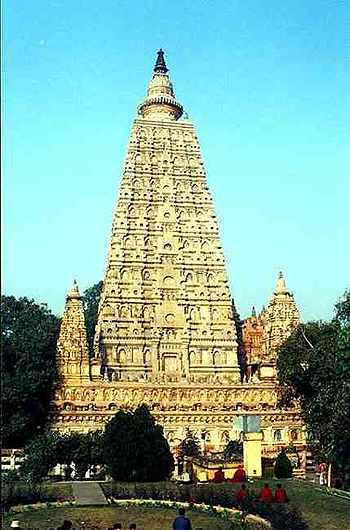|
According to the Jataka tale, when Buddha first came here (after checking
out some rather frightening places), the Papilla, or Indian fig (Bodhi)
was a massive tree. It stood at the centre of a mandala composed of a
silver white sandy ridge, encircled by creepers and a grassy woodland
with all the trees inclining towards the Bo tree that stood in the middle.
Close by were the pure, glassy waters of the Neranjara river, with many
pleasant bathing pools. When he sat down in front of it facing East, a
long vista opened out to through an avenue of Sale trees to the glistening
beach of the crystal Neranjara. Thus it was 2,500 years ago. Very beautiful.
After he left, he never looked back, and never visited again. But he
did recommend it as one of the four memorable places worth visiting for
inspiration.
Buddhist believe this is the navel of the universe, the vajra seat, where
past and future buddhas achieve the ultimate state.
Still, no one seems to have taken any notice for around 250 years.
The Buddhist emperor Asoka went there after being in power for 10 years,
and again 10 years later. This time, he set up a stone pillar with an
elephant capital here, as well as similar pillars at Lumbini, Sarnath
and Kusinara. (Birth first teaching and death spots). He also sent a branch
of the still living tree to Ceylon, where it was successfully planted.
This all happened around 250 BC.
A good thing, as his queen got jealous of her emperor’s devotion, and
had the original tree destroyed. A new one was quickly planted.
Another 150 to 300 years pass, then a couple of devoted women have some
work done. One, an elderly matron who’d been married to a local king was
called Kurangi. To perpetuate the memory of her dead husband, she built
an open pavilion, supported on stone pillars, surrounding the tree and
the "vajra-asana", or lion seat, the actual spot in front of the tree
where the Buddha had sat. To the side, where Buddha had walked up and
down for 7 days after achieving the sublime state, a "jewel walk" was
constructed, a stone lotus petal for each of his footprints. A sandstone
throne was formed over the spot where he had sat, and a sandstone railing
was built right around the whole construction as well.
This gives us the 5 essential parts of the site, which can still be found
(in an evolved form) today: tree, throne, jewel walk, temple and stone
railing.
|
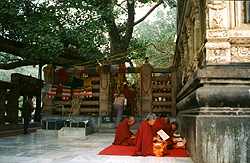
The current Bodhi tree, within a small enclosure that
also houses the varja seat (between the tree and the temple, directly
above the monks, in behind the fence)
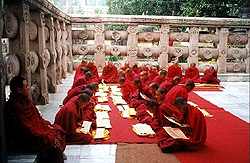
The restored / rebuilt sandstone railing, very similar
to the original
|
|
The first of many Chinese pilgrims who thoughtfully took good notes (and
left them behind for prosperity) arrived not long afterwards, around AC
400. (So already 900 years have passed since the Buddha was there, and
the open pavilion has been standing maybe 400 years). Fa-hien records
that there are now some statues of the Buddha in the open pavilion. He
also notes that the whole area has become filled with monuments to specific
instances in the Buddha’s travels to and from the spot. There are also
monasteries, filled with monks keeping strict vows.
Sometime in the next 200 years, there is a very major change. When the
next Chinese pilgrim (Hiuen-tsang) visits around AC 635, the Mahabodhi
stupa, remarkably similar to what we see today, has appeared. He took
accurate measurements, both here and at Nalanda, where there was a similar
stupa/temple. This means it was built around 1,500 years ago, or 1,000
years after buddha had passed through.
The most popular current theory
(presented in the book) is that the temple was built by a Brahmin minister,
acting on advice given him by Shiva. His brother (on the same advice)
excavated the tank (lake) alongside, where Buddha had washed. Presumably
these brother had the support of the local king. Shortly afterwards, King
Puavarma (Ac 600-620) built a new 24 foot wall around the site, and planted
another Bodhi tree in the time honored spot.
During Hiuen-tsang’s visit, there
were many other smaller temples, containing statues of the Buddha, and
a very large monastery on the North side (where the mall and shops are
now). This monastery had been built by the King of Ceylon (Shri Lanka),
and had 6 courts, was three stories high, and surrounded by a 30 to 40
foot high wall. It had come about because of a pilgrimage by the king’s
brother, who had returned home most upset, with a permanent stutter. This
was the result of the appalling manners displayed by the locals. His brother,
the king, was not amused, and quickly took steps to make sure no foreign
pilgrims in the future would be treated so inhospitably. Or at least not
ones from Ceylon.
|
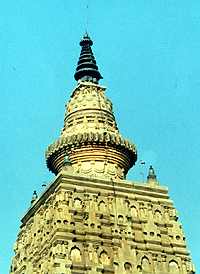
top of restored mahabodhi temple
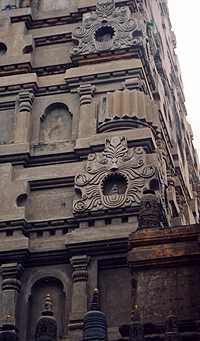
closeup of side of mahabodhi temple
|
|
The main temple had a different entrance. There were 3 lofty halls interconnected,
and 10 foot high silver statues, one on either side. It is not at all
sure there were four miniature towers as seen today at the corners. These
were put there by the British restorers. (More below)
What is interesting, is that the original lion throne, jewel walk and
stone rail and pavilion pillars had been all torn down to build this new
temple. Some of the old foundations were found by British restorers under
the foundations of the current temple.
It must have been an amazing place. You could spend weeks on the local
tour, following in the Buddha’s footsteps, reliving the golden moments
at your leisure, with delightful rest houses and monasteries at every
hallowed spot
Not long after this, a Chinese official brought silk robes for the main
image (AC 680 ish). During the 8th and 9th century,
there was a slight decline. In the 10th century wealthy patrons
sponsored new statues and shrines. In the 11th century, 2 Burmese
missions came. In 1035, the Burmese plaque reckons the temple has been
rebuilt three times already. During this time local kings also patronised
zealous monks who wished to do repairs.
All through 12th and
13th century the Burmese were very active in sending teams
to restore the temple, despite their own country being invaded by the
Chinese. By 1305, they had completed the complete repair and restoration
of all the walls, including the stucco facings, and side buttresses.
A Tibetan monk visited around
1235 and found 300 Sinhalese monks in residence.
By now the Muslin invaders have
well and truly invaded India. 1232 was the year the Qutub Minar was built
in Delhi.(If you don't know what means, Indian History is obviously a
mystery you have yet to unravel)
It is not clear when exactly Mahabohi
was sacked, but sometime during the 13th century. For the next
(approximately) 350 years, it was abandoned, in ruins, ending some 1500
years of continuous occupation by practicing Buddhists.
Around 1590, a wandering Hindu
arrived and settled down on the river bank near the ruins, gathering disciples.
A few generations later, the Muslim emperor in Delhi gave the successor
vast amounts of property in the area, including a couple of local villages
(the ruins weren’t specifically mentioned). The old temple was never actually
converted to a Hindu shrine, although some extra buildings were established
for Hindu worship.
In 1811, the Burmese came back
to work again, and the next year, 1812, sees the first visit of a European
archaeologist. A few years later, the current leader of the Brahmins starts
to claim the actual ruins as his.
The Burmese came back again in
1874, with lots of gifts for the Govt. of India (English, by this time,
Muslins and Hindus both beaten into submission), to encourage them to
offer assistance to Buddhist pilgrims, and to pay for the restoration
of the temple. The British asked the local Bhramin if this would be okay,
and he raised no objections, so work got underway. General A Cunningham
came to supervise, and his work is were well covered in Root Institute’s
page on the history of the Mahabodhi stupa, where there are also great
"before" shots showing how much destruction had been wrought. Mind you,
if the stupa at Nalanda was identical, then Mahabodhi got off very lightly,
as the Nalanda one was reduced to a pile of bricks, (photo) The good general
was also there when the two current Bodhi trees were planted.
|
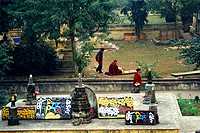
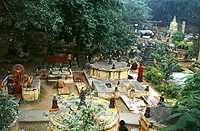
|
| In 1889 the work was
finished, and a couple of years later a young man from Shrilanka visited:
Anagarika Dharampala. He was inspired, and formed the Maha Bodhi Society.
He devoted the rest of his life to trying to get control of the temple restored
to the world’s Buddhists. He hated that the Hindus were desecrating the
shrines, and carting away relics to use in private houses. His life long
struggle makes heart-rendering reading, and he died without completing his
task. Several times he was beaten, and spent a fortune in protracted legal
battles. My own personal interpretation of this (lengthy) section of the
book is that the British Colonial Government preferred to back a (local)
Hindu, rather than handing over control to a group of (foreign) Buddhists.
Especially as one of the biggest, most powerful groups of Buddhists was
Japanese, and the British distrusted their motives. In other words, it was
political, and very painful for the Buddhists. |

bust of Anagarika
Dharampala outside the Maha Bodhi Society Building in Bodgaya
|
|
Finally, after independence, in 1949, an act of Parliament was passed
covering how the temple complex was to be administered. This is still
in effect today. There is a committee, of four Buddhists and four Hindus.
They first met in 1953, and since then have done a great deal to upgrade
the facilities. In keeping with many of the previous repair jobs, I noticed
that the stucco repairs done in 1968 are already failing (reinforcing
steel bursting out). In 1973 the Buddha Gaya temple Advisory Board was
formed. This has 21 members, including representatives from Thailand,
Laos, Burma, Sikkim, Cambodia, Bhutan and Ladhak. Nearby are a museum,
a library, lots of new temples and guesthouses to suit every inclination
|
|
|
There is now a very nice marble walkway around the whole site, and an
imitation Asokan railing / fence. The place is flood lit at night. The
upper shrine is a sanctuary for silent meditation, open to all. Tibetan
artists are busy painting gold on to all the images. The grounds are filled
with wooden prostration boards where Tibetans, Europeans and Asians work
out their sweaty routines in murmured harmony. Practictioners of every
age and nationality wend their ways around the three different circumambulatory
paths, or sit on the lawns and under the trees. Indian tourists are (almost)
reduced to respectful silence. It's a place where any buddhist feels at
home.
|
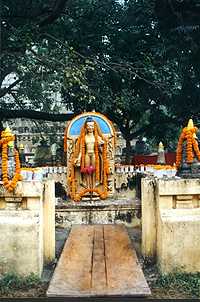 |
